#SeasonalSundays
Text
The Harvest Bat
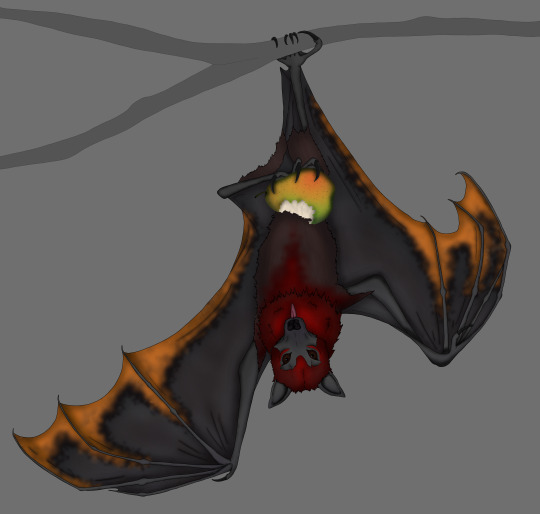
The Harvest Bat has a diet as diverse as its color palette, feasting on as large a range of fruits as they can get their claws on. Harvest bats don’t just eat fruits, either, but have also been seen feasting upon various roots and vegetables. In fact, harvest bats got their name from the harvest season, and any crop that gets harvested during this time is one that you might find a curious harvest bat feeding on.
Harvest bats range in size as well, but they’re notable for being a fairly large species on average with most adults reaching the size of the largest flying foxes - and sometimes even larger! While their large size might be off-putting to some, the harvest bat is extremely friendly. It doesn’t take much of an offering to get a harvest bat to perch on your arm while it munches on whatever fruit you’ve given it (and it won't mind some pets, either).
Another reason that the harvest bats are named as such is due to the fact that they’re only seen in the open during the harvest season. This isn’t to say that the bats are unseen throughout the rest of the year, but they’re much more seclusive. Outside of the harvest season, these bats retreat to large cave systems where they spend most of their time. It is believed that the bats switch to a more insectivorous diet during this time, and the harvest season is a time for the bats to stock up on energy for the year. Studies on this behavior are limited as the bats are hard to track once they retreat for the year.
#ah#the spooky bay for the spooky season#a little late from Halloween but whatcha gonna do#I named these bats before I did a lick of designing#so they went through a few versions#one version even leaned more towards a soul harvest#but I went for the more wholesome option#for once#but man did they make me crave pears...#SeasonalSundays#Fall#Autumn#Harvest Bat#bat#fruit bat#pear#digital art#concept art#creature concept#creature art#animal art#my art
11 notes
·
View notes
Photo

From @julbeartinteriors - I'm delighted and thankful to be featured in the #Barbados Nation #newspaper @nation246 Easy magazine's 'A November to Remember' special. I styled two tablescapes in my formal dining room and morning room paying tribute to Barbados, using the colours of the national flag. On November 30th, Barbados celebrates its 51st Anniversary of nationhood! Happy Independence Barbados! 🇧🇧💙💛💙. . . . . . . #Bajan #Bim #blue #interiors #interiordesign #blueroom #blueandyellow #interiordesigner #tablesettings #tablescape #diningroom #Dinnerparty #bhgcelebrate #homefortheholidays #holidaydecor #seasonalsunday #colourpop #myhousebeautiful #myjoyfulseason #wowusweekdays #interiordesignersofinsta #DesigningDelaware #JulBeArt #JulBeArtGardens #JulBeArtCooks #JulBeArtInteriors Connecting Barbados @the246connect
#blueandyellow#bim#barbados#homefortheholidays#seasonalsunday#holidaydecor#designingdelaware#interiordesigner#dinnerparty#wowusweekdays#interiors#blue#blueroom#newspaper#tablescape#myhousebeautiful#myjoyfulseason#colourpop#diningroom#julbeartinteriors#julbeartcooks#tablesettings#interiordesign#bhgcelebrate#julbeartgardens#interiordesignersofinsta#bajan#julbeart
1 note
·
View note
Photo

CHIHULY CONCERT • AD This weekend we went to @chihulygg for one of their #SeasonalSundays concerts. We listened to the @northwestgirlchoir perform in the gorgeous Glasshouse - they sang beautifully and the holiday songs paired with the amazing artwork was a special way to celebrate the season. There’s still one more concert this Sunday (12/22) so plan your own visit. The concert tickets are included in your admission - and you get discounted admission after 4pm, just in time for the concert! . Have you had any fun holiday excursions this year? . . . . @travelmindset #chihulygardenandglass #chihuly #seattlewashington #seattletravel #seattle_igers #seattleliving #seattlelove #seattlepulse #seattlemusic #seattlecity #seattlesbest #exploreseattle #seattlemusicscene #sonorthwest #seattlemom #seattlebloggers #thegreat206 #seattle_sites #seattledowntown #seattleigers #seattlecenter #emeraldcity #visitseattle #thingstodoinseattle https://ift.tt/2Z2csDI
0 notes
Text
The Glacial Basilisk
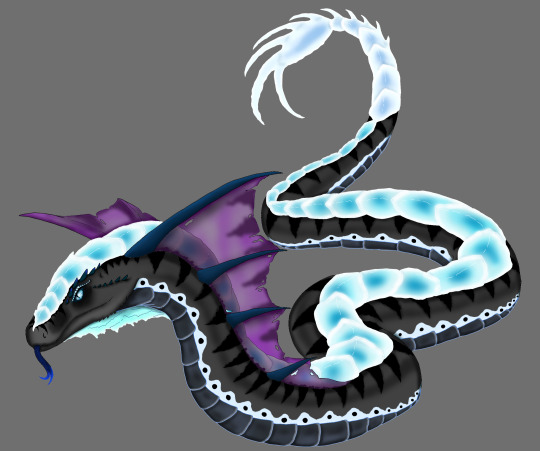
Did you know? - The glacial basilisk is extremely territorial, defending its chosen lakes fiercely. Large, frequented lakes are highly sought-after real estate, and a basilisk will do whatever it can to maintain control over such a lake. Most of the time, territorial disputes are solved using displays. The basilisk’s large fins are used minorly in swimming but are otherwise tucked into its side. These fins become fully extended and will even rattle in a striking territorial display. The color and size have less to do with deciding the winner than the aggression of the display itself. If neither basilisk withdraws, the dispute can become physical. Basilisks will avoid stinging each other with their spines as it is easy for a basilisk to sting itself in the process. Their counter-venom is limited and resupplies slowly, so neither basilisk wants to risk having to use such a precious resource.
There are some lakes that the basilisks are willing to share, but these are rare cases reserved only for the largest of lakes. These temporary truces can be beneficial to both basilisks as it is much easier to drive off competition with more basilisks defending.
As the temperatures rise toward the height of summer, the glacial basilisk begins its hibernation period. As their lakes begin to thaw, the basilisks retreat to areas that are stuck in a permafrost. During this period, the basilisk is much more willing to temporarily share lakes as its territorial nature wanes. The hibernation period is short, just long enough for the ice to start freezing in their natural habitats again before the basilisks drive each other out of their territories once more.
#oh hey#its the dark one#you'll see this become a trend#what else was I gonna make it?#purple?#haha#jk...#unless?#SeasonalSundays#Winter#Glacial Basilisk#basilisk#snake#digital art#concept art#creature concept#creature art#animal art#my art
2 notes
·
View notes
Text
The Harvest Bat
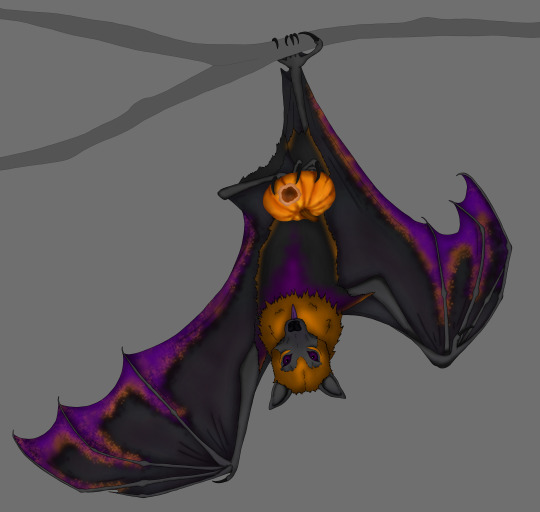
Fun Fact! - There is a harvest bat variant that is colossal, even compared to the rest of the already large bat species. The Pumpkin Harvest Bat is one of those creatures of legend, regarded by most as a fun Halloween story and nothing more. The story is thought to have originated from parents as a warning not to leave their carved jack-o-lanterns out for too long (lest the pumpkin bat snatches it away, and might just snatch you up too!). And, according to the sightings, this variant bat is certainly large enough to pick a child up off its feet, albeit not for very long.
Despite the fact that this pumpkin bat hasn’t been officially recorded, there are those who swear to its existence. Amidst the most staunch believers are pumpkin farmers themselves. The small group of pumpkin farmers in the area recount tales of leaving fully grown pumpkins out in the woods, a mimicry of the practices used by farmers of much smaller fruits. Just like the offerings of other orchards and gardens, these offerings would disappear overnight. With the disappearance of these pumpkins would come the largest, healthiest pumpkins these farmers had seen in their careers. Even pumpkin farmers who don’t follow this practice have found entire pumpkins missing from their patch, not a footprint or trail in sight as if it had been plucked from the skies.
Despite their belief, even pumpkin farmers haven’t seen the elusive pumpkin harvest bat, only seeing brief glimpses of purple and orange. True or not, the farmers figure that it does little harm to let go of a few pumpkins per harvest to feed what may well be a superstition.
The magic of harvest bats and colossal pumpkin bats is an innocent magic to believe in. Much more innocent than the tales of bats who hunger for something a little more sinister than fruits, that’s for sure.
#you know I had to make a spooky Halloween bat#it wouldn't be like me not to#the size of the pumpkin in its claws?#up to interpretation#just remember not to leave you pumpkins out#or do#see what happens#might be fun to get carried by a big ol bat#SeasonalSundays#Fall#Autumn#Harvest Bat#bat#fruit bat#pumpkin#digital art#concept art#creature concept#creature art#animal art#my art
1 note
·
View note
Text
The Harvest Bat

Did you know? - A harvest bat’s appearance will often match the fruit (or other food) that it specializes in. For some, this is only minor color matching, but other variants are a much clearer match. While an individual harvest bat will eat just about anything, there are these subgroups that overall choose one fruit above all else. It’s said that, if you offer a harvest bat their fruit of choice, it will keep coming back to you each year to get more.
This is a behavior that farmers have learned to exploit. The bats may be expected to be seen as a pest, but they can actually be satiated quite easily by offerings. All a farmer has to do is leave a little bit of their harvest out in a secluded spot on their farm and, for the most part, the harvest bats will take their offerings and move on. This has become quite the tradition for those who have farmland in harvest bat territory.
But preventing the bats from tearing through crops isn’t the only benefit farmers have found. Whenever these harvest bats are near, surrounding crops seem to have an almost unnatural vitality. Crops that may be ravaged by pests throughout the rest of the year may find themselves flourishing during the harvest season. Plants that shouldn’t be able to grow under certain conditions may suddenly sprout against the odds. It’s believed that the famous Snow Apple is grown this way, that the harvest bat is responsible for the icy-crisp apple variant’s ability to thrive in such cold conditions.
This phenomenon isn’t understood, or even widely believed, and as with many things that we don’t understand there are a variety of theories. Some argue that the omnivorous bats simply keep pest populations down to give the crops the best chance at survival, others argue that the bats are full-on harvest spirits. Still, many can agree that leaving a little something for the harvest bats makes the harvest season just a little easier. And for farmers, that’s all they need to understand.
#this one might be my favorite#but I have a red-black-white combo bias#and an apple bias#and just a red in general bias#also the fact that I made it mostly white is what inspired the Snow Apple thing!#cause its not me if I'm not making up lore retroactively based on the fully designed creature#SeasonalSundays#Fall#Autumn#Harvest Bat#bat#fruit bat#apple#digital art#concept art#creature concept#creature art#animal art#my art
1 note
·
View note
Text
The Aviraptor

Fun Fact! - Aviraptors come in a wide range of colors, both in their feathers and the membranes of their wings. The color range of the aviraptor is well documented, especially as the fall season allows researchers to get closer without as much danger of getting maimed. While many of the aviraptor’s features have been studied extensively - from their colors to their intricate behaviors and stunning intelligence - there is one thing that still seems to defy explanation. The Silver Aviraptor isn’t initially all that unusual. While its colors are more muted than would be expected from the species, it still has enough lightness to its markings to fit with the rest of the crowd.
What is unusual is the silver aviraptor’s behavior and legacy. The variant has almost always been documented in a hunting party, and every time it is the leader of these temporary packs. It commands a unique level of respect, never seen in fights and so far not documented as having any scars.
The largest issue comes with the fact that this variant is thought to not even be a variant at all. The silver aviraptor with striking eyes has been sighted for as long as the species has been known. Yet, there has never been a sighting of any more than one individual throughout history. Furthermore, it has evaded direct study as well, seen only in brief moments.
There are two running theories that no one is truly satisfied with. Theory one states that this combination of coloration and behavior is so rare that the chances are that there is only one individual at any given time. Theory two is more exciting, but much less plausible. Perhaps, this ‘variant’ is in fact a single individual, transcending time, that has been alive since the beginning of the species. While the chances of this theory being true are slim, there are those who stand by it simply in the hope that such a thing can be true.
#this one is my favorite#I like the original since red is still my bias#but man#I really like how the colors on this one turned out#I knew I had to give it some mysterious backstory#its only fitting#SeasonalSundays#Fall#Autumn#Aviraptor#raptor#dinosaur#bird#digital art#concept art#creature concept#creature art#animal art#my art
1 note
·
View note
Text
The Aviraptor
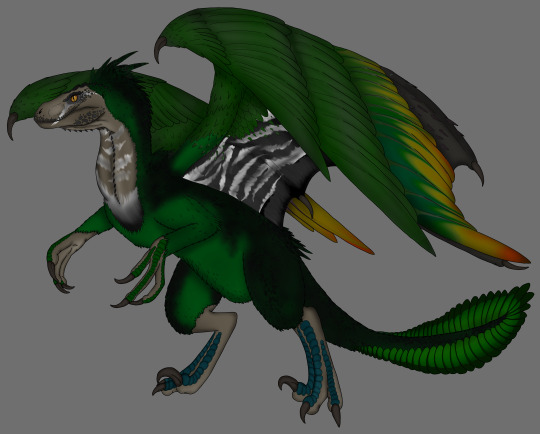
Did you know? - Aviraptor social structure is loose and fluid. While the theropods prefer to hunt alone for small prey, they will occasionally group up to hunt larger creatures together. A flurry of sharp teeth and formidable sickle claws is too much for even large animals to handle. These hunting parties are small, no larger than five individuals at a time. Group dynamics are fluid, with aviraptors coming and going and the current ‘alpha’ changing between hunts. If group sizes get too large, the aviraptors will become territorial and may even begin fighting if they don’t disperse first. Likewise, if a group takes down a prey item they will only share with members of that hunting party. If an outsider comes along, even one that the group has hunted with before, the hunting party will jealously defend their catch.
As temperatures start to cool and leaves start to fall, the aviraptor goes through an interesting behavioral change. The theropod becomes uncharacteristically… agreeable. This mainly comes in the form of their group dynamics, as aviraptor packs become larger and infighting greatly decreases. Because autumn is their mating season, this allows the aviraptors to congregate together to begin mate selection without the risk of fights breaking out between potential partners. Their agreeability means that aviraptors use their brightly colored wings and feathers in dazzling mating displays as opposed to the fighting that they would otherwise employ during the rest of the year. In fact, during fall, their colors will become even more vibrant to increase their chances of finding a mate.
While it makes sense that these aviraptors will become more tolerant of each other during this time, it is their interactions with other creatures that baffle behavioralists. Aside from the small prey that makes up most of their diets, the aviraptors' curiosity for other creatures begins to err on the side of friendliness. This can be unfortunate as, if someone were to be introduced to this species during this time, they may have the misconception that these creatures are curious and amiable. This illusion would be quickly broken if they were to meet these same creatures once the seasons shift again.
Still, there are those who eagerly await the fall season so they can get up close and personal with these dangerous predators. And every year, there are those handful that learn the hard way that, agreeability or not, all predators are capable of showing their true colors if pushed.
#I was goona make this a lot more wild#more vibrant#kinda like the first one#but then I landed on this really nice dark green#so I rolled with it#and frankly#I like how it turned out in the end!#SeasonalSundays#Fall#Autumn#Aviraptor#raptor#dinosaur#bird#digital art#concept art#creature concept#creature art#animal art#my art
0 notes
Text
The Aviraptor
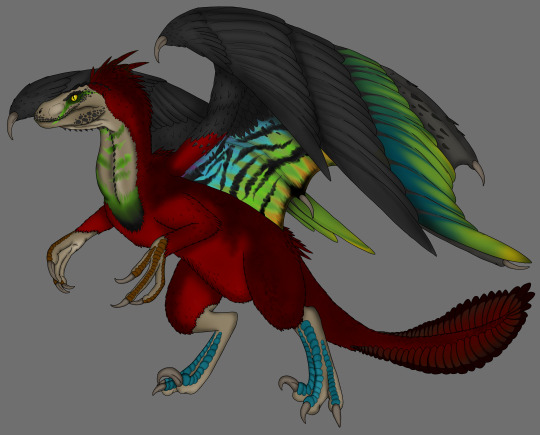
The Aviraptor is another impossible remnant of the past that science has been fascinated with since its discovery. This theropod, true to its dromaeosaurid lineage, is as fast as it is intelligent. Despite the creature’s bright colorations, it is still an ambush hunter as expected for a raptor. The main departure from true raptors is the aviraptor’s large pair of wings. These wings are heavily feathered, but closer inspection reveals that these feathers attach to a leathery membrane, more akin to a bat wing than that of a bird.
Unlike many large, winged creatures, the aviraptor is capable of fully powered flight, though not for any extended period of time. Capable as it may be, the aviraptor still mainly chooses to use these wings as an aid in running. Still, the aviraptor has no trouble scurrying up a tree or cliff and flying to its next destination.
Though the feathers of the aviraptor’s wings help its flight, they are mainly for displays. When the creature loses these feathers, it is still perfectly able to glide and fly. In fact, the aviraptor’s feathers routinely fall off and regrow once a year during autumn. This mandatory molting keeps the feathers strong and healthy.
Even though the aviraptor is a large creature, it has a preference for smaller prey items. This allows the aviraptor to basically run down its prey, overwhelming the smaller animals with lethal efficiency and agility. Prey are as safe in the trees as they are on the ground as the aviraptor is comfortable tearing through foliage and branches. Because of the lift the aviraptor’s wings provide, the theropod spends less energy chasing prey. By choosing small prey, the creature can ensure that it gets food without having to grapple with prey that can potentially harm it. The lift from the wings even allows the aviraptor to run faster and further without tiring, making it a true pursuit hunter.
#Ayy#its another hexapodal prehistoric creature!#we've pretty much covered by favorite dinosaurs now#first spinosaurus and kaprosuchus with the Suchoptera#and now raptors with the aviraptor!#I was thinking about which bird to base it off of#and somehow I landed on macaws#maybe because red is my favorite color and I have a bias#maybe#my big raptor bb#SeasonalSundays#Fall#Autumn#Aviraptor#raptor#dinosaur#bird#digital art#concept art#creature concept#creature art#animal art#my art
0 notes
Text
The Leaf Kitsune

Fun Fact! - The leaf kitsune is one of those creatures that strays just far enough into mysticism that science can’t account for everything. For this reason, the myth has run with science’s lack of explanation to create its own, going as far as rumors of these kitsune being shapeshifters that can traverse the land of the spirits. Kitsunes are seen as troublesome, but myths of spirit guides and guardians of memory paint the creatures in a much more benevolent light.
Yet there is one variant among the kitsune that both science and myth can agree on; the Ash Kitsune isn’t to be messed with.
It isn’t uncommon for a leaf kitsune to almost beckon travelers deep into the woods, amping up its playful facade to invite them to step off their path. This journey usually leaves the traveler lost at best and in a dangerous part of the woods at worst. This is not the case with the ash kitsune. This variant is mostly the making of folklore, said to embody the darkest fate of a forest - a devastating fire.
Leaf kitsune are found in as far a range of colors as the leaves that flutter around them - displaying green fur as the seasons begin to change and reds and oranges once fall is in full swing. There have even been sightings of brown kitsune surrounded by dried leaves. The ash kitsune is no exception to this pattern, surrounded by leaves charred as black as its fur. These leaves aren’t just burnt, they're actively glowing with embers. Some believe that the ash kitsune is created after its forest burns down, a regular kitsune changed at the destruction of its home. Others have a darker outlook, suspecting that it is the ash kitsune that does the burning as its fluttering leaves can set others ablaze as well.
But no matter the origins, the seldom few that have seen the ash kitsune have reported deep feelings of dread and despair as if looking upon death. Gone is the usual mischief and curiosity in the kitsune’s eyes, leaving only pointed malice. Those who are said to have seen the ash kitsune will defend its existence with fervor, but there is little tangible evidence. Many find it much more comfortable to dismiss these sightings as visions born from smoke inhalation and stress. Others worry about the stories of people - of bodies - found in the midst of burning woods. The stories that never got to be told.
#okay I hate to sound like a broken record#BUT#the ash kitsune is NOT YOUR FRIEND#and also its not even trying to be#a regular kitsune wants to have some twisted fun#the ash kitsune wants to see you walk into a fire#this variant happened because I couldn't think of any more leaf variations#I only just now thought about dried leaves#man#that would've been a lot more wholesome#SeasonalSundays#Fall#Autumn#Leaf Kitsune#kitsune#fox#leaves#digital art#concept art#creature concept#creature art#animal art#my art
0 notes
Text
The Leaf Kitsune

Did you know? - The leaf kitsune is known as a mischievous omen with the same sly nature that characterizes many kitsune. For some reason, people still tend to treat the leaf kitsune as if it were more amicable than it has historically proven to be. Something about the animal’s appearance makes most assume its curiosity comes from a place of good intentions and friendliness. It rarely does, and the multitudes of stories telling of travelers getting lost in some of the most dangerous parts of the woods prove it… As curious as the kitsune is, it seems to make those who observe it almost detrimentally captivated and distracted.
However, for as many stories as there are, it is actually quite uncommon to see a leaf kitsune in the wild. Firstly, the elusive creatures are almost never seen outside of the fall season, though there have been a few anecdotal sightings as far out as late winter and early summer. Although the kitsune have more seasonal range than creatures like the starlight deer, they remain even more scarce. When leaf kitsune are found, they are spotted alone, rarely found in pairs but never more. There is one exception; a mother kitsune and her kits. Even still, rumors of kit sightings are highly scrutinized as each one has happened under stranger circumstances than the next, often in the midst of being lost in the woods and near delirium.
Even the adults are shrouded in mystery as there hasn’t been as much as a reported sighting of any hunting behavior whatsoever. In fact, there hasn’t been any evidence of the fox-like creatures being hunted, either, and remains have yet to be found. The creature has accepted treats from hikers, but that seems to be the extent of it. The many enigmas of the leaf kitsune have made the belief that the creatures are as mythical as legends once suggested all the more popular, even among science and skepticism.
#listen#I often watch animal videos and have to remind people that [insert animal] is not your friend#like squirrels#squirrels aren't your friend#they will bite you#so lemme just say this:#the leaf kistune is not. your. friend.#it isn't leading you on a 'fun journey'#it hasn't 'chosen' you becasue you're 'special'#its leading you to a poison ivy patch because its bored#still cute tho#SeasonalSundays#Fall#Autumn#Leaf Kitsune#kitsune#fox#leaves#digital art#concept art#creature concept#creature art#animal art#my art
1 note
·
View note
Text
The Leaf Kitsune

The Leaf Kitsune is a true herald of the autumn season, embodying the changing colors and foliage that this part of the year is so known for. The fox-like creature is often followed by a gentle fluttering of leaves, even in otherwise still air. These leaves may continue to flutter in the creature’s wake, making this a popular method of tracking the otherwise hard-to-spot kitsune. Fallen leaves will often temporarily stick to the kitsune’s plush fur, giving the animal an overly innocent look for its not-so-sweet demeanor. As autumn reaches its peak and the leaves change even more drastically, the fur color found on the leaf kitsune changes as well. As this transition happens, the kitsune will mainly attract leaves that match its fur color.
This isn’t the leaf kitsune’s only captivating feature, as it is the creature’s tails that make it a true kitsune. These tails are usually seen in a set of three, often differentiated by tints and shades. And yet, there have been sightings of these creatures with up to nine tails cascading behind them, floating in the breeze. Old beliefs once said that the creature magically multiplied its tail - and frankly, it wouldn’t be the strangest thing that these foxes have been known for. The truth is, this is the work of illusion over magic. The fur on the leaf kitsune’s tail is so fine and plush that, when tails are held together, the fur layers combine and appear to be one. When the leaf kitsune encounters a being of interest, it will shake out its tails to display all nine, waving them in an almost hypnotic fashion.
Between the fluttering leaves, the seemingly weightless tails, and the almost otherworldly grace that the leaf kitsune carries itself with, watching this creature can be a captivating experience. One must take care to keep their distance, though, or else they may come back into focus only to find themselves far off from their intended path.
#if i had a nickel for every leaf-themed fox creature I've created#i'd have two nickels#which isn't a lot but it's weird that it happened twice#(especially when you consider that drawing foxes takes years off my life)#listen#I love foxes#one of my favorite animals#but there's something about the face that I just...#cant comprehend#but I do love this leafy bb#just remember#the leaf kitsune is NOT your friend#do not follow it.#please.#SeasonalSundays#Fall#Autumn#Leaf Kitsune#kitsune#fox#leaves#digital art#concept art#creature concept#creature art#animal art#my art
0 notes
Text
The Eclipse Axolotl

Fun Fact! - Eclipse axolotls are colorful by nature, but this variance is usually restricted to their fins and markings, which can become quite vibrant. Their base skin tone is usually more muted and earthy, coming in a variety of neutral colors. While some variants have lighter skin, there is one that stands out by being both light and vibrant; the Lunar Eclipse Axolotl.
These light blue axolotls are named after the white color of their halos, a feature found exclusively and unanimously in this lunar variant. Interestingly, the usually bright colors of the axolotl’s ‘star’ markings are inverted into a deep black, likely to contrast against the variant’s light skin. While these markings don’t glow, they still shimmer under the moonlight as the more typical markings do.
This blue color isn’t merely a cosmetic change, this is the rise of aposematic coloration. But the aposematism isn’t in response to the axolotl’s normally toxic insides. Instead, the lunar axolotl has toxicity in an external organ; the skin. Most eclipse axolotls lose their internal toxicity as they enter hibernation, and this is true of the lunar variant as well. Their skin toxicity, however, remains as toxins are held in the tissue throughout their dormant phase. While this certainly evolved as a response to predation during hibernation, it isn’t a complete fix. The blue skin of the lunar axolotl makes them more conspicuous, making it harder for them to hide from the few predators that can tolerate their toxins.
#this one was kinda random#I didn't have any concrete ideas#so I just messed with some sliders until I found something fun!#and this axolotl is very fun#SeasonalSundays#Summer#Eclipse Axolotl#axolotl#eclipse#amphibian#digital art#concept art#creature concept#creature art#animal art#my art
0 notes
Text
The Eclipse Axolotl

Did you know? - The eclipse axolotl is extremely toxic, or at least its inner tissues are. When ingested, these tissues can cause severe and rapid sickness in predators. The bitterness of the toxin is often enough to make predators release the axolotl after one bite, allowing the creature to live on and quickly heal its wounds. Their toxicity is one of the main drivers of their friendliness in fact, and the axolotls completely depend on their reputation to keep them safe.
Despite being a relatively new species in the grand scale of evolution, there are already predators that can handle the eclipse axolotl’s toxins. These predators are ones that have already evolved resistance to other toxic creatures in the environment and are often able to palate the eclipse axolotl with only minor difficulty.
The tissue toxicity isn’t permanent, however. When the eclipse axolotl hibernates during the colder months, they stop producing the toxin that makes them potentially deadly. While this conserves energy during hibernation, it also puts the axolotls at an increased risk as they no longer have a deterrent to prevent predation. For this reason, these axolotls take great care in choosing a site to hibernate in. Hibernation locations have to be hidden enough to avoid would-be predators, but also have to be open enough to continue aerating the axolotl’s gills.
#ok ok its the Dark One#but its also the maroon one!#a dusky boi#nothing else to say#I just love my lil guys#SeasonalSundays#Summer#Eclipse Axolotl#axolotl#eclipse#amphibian#digital art#concept art#creature concept#creature art#animal art#my art
1 note
·
View note
Text
The Eclipse Axolotl

The Eclipse Axolotl is named for the fin-like gills that crown its head. These gills have a glowing halo that is reminiscent of a solar eclipse, especially when in low light. These amphibians are also called ‘Star Axolotls’ for the small glowing markings that dot their bodies. They are rather large for axolotls, and their fins are much thicker. Their skin still maintains the expected thinness of an amphibian and these axolotls are quite sensitive to changes in their surroundings. Despite this, the axolotls are able to adapt quite well to these changes - so long as they aren’t temperature-based.
Many have described the eclipse axolotl as ‘unsettling’ thanks to its large, glowing, unblinking eyes. This isn’t helped by the fact that the creature is curious by nature, causing it to stare directly at any new thing that has entered its habitat. If one can get past the stare, these axolotls are actually quite amiable, even friendly to familiar faces.
As soon as the waters begin cooling, the axolotl prepares itself for hibernation. They are at their healthiest when their waters are warm, and their health can deteriorate rapidly if this condition isn’t met. They are so sensitive to temperature that they can die overnight if the waters cool too drastically. To avoid this, the axolotls hibernate until their waters become consistently warm once again. Tadpoles hatch prior to this hibernation period, and from then on it is a race for them to grow to an adequate size and hibernate themselves before the water turns too cold. These young are slightly more tolerant of cold than adults, but many hatchlings still don’t make it in time for the changing of seasons.
#this is one of my favorites#I always neglect amphibians in my art#which sucks cause they're so cool!#so I'm trying to change that#plus axolotls are rad#but you already knew that#SeasonalSundays#Summer#Eclipse Axolotl#axolotl#eclipse#amphibian#digital art#concept art#creature concept#creature art#animal art#my art
0 notes
Text
The Bloodburst Rattlesnake

Fun Fact! - Because of the bloodburst rattlesnake’s appearance and tolerance for diverse climates, the snake used to be a popular entry in the pet trade. This trade boomed for a little while thanks to exotic pet keepers, but allure quickly diminished thanks to the snake’s aggressive nature and highly venomous bite. Still, within the years that the bloodburst trade was strong, breeders were able to pull a range of morphs from the snake's already beautiful wild coloration. While there used to be dozens of these morphs, after many snakes were released back into their natural habitats, most variations were selected against and were lost to the populations. Now only two morphs remain as a testament to the old pet trade.
The ‘anemic’ bloodburst rattlesnake was named for its muted colors; even down to a usually golden rattle becoming more of a muted yellow. These rattlesnakes appear to be albino thanks to the remaining red color but are technically leucistic as they still have pigments that prevent the sun’s rays from harming them. In fact, these paler snakes take to more arid regions, almost akin to their typical rattlesnake cousins.
The second morph is the ‘blueblood’ rattlesnake, a stark contrast from the red wild type. These blue and purple snakes were once the crown jewel of the bloodburst pet trade, not only for their colors but also for their reported ‘calm demeanor.’ In fact, these ‘cool blue’ snakes were marketed like this during a time when the pet trade was beginning to fall due to the species’s aggressive nature. This morph’s venom was even reported to be less potent, but these weak rumors did little to save a dying pet trade. Now that the snakes are wild, we know that the blue color of these snakes does little to change their hot-tempered nature.
#blue snake!#blue blood to be particular#good ol therium snake#it was the only next step#my blue bb#SeasonalSundays#Summer#Bloodburst Rattlesnake#rattlesnake#snake#reptile#digital art#concept art#creature concept#creature art#animal art#my art
0 notes